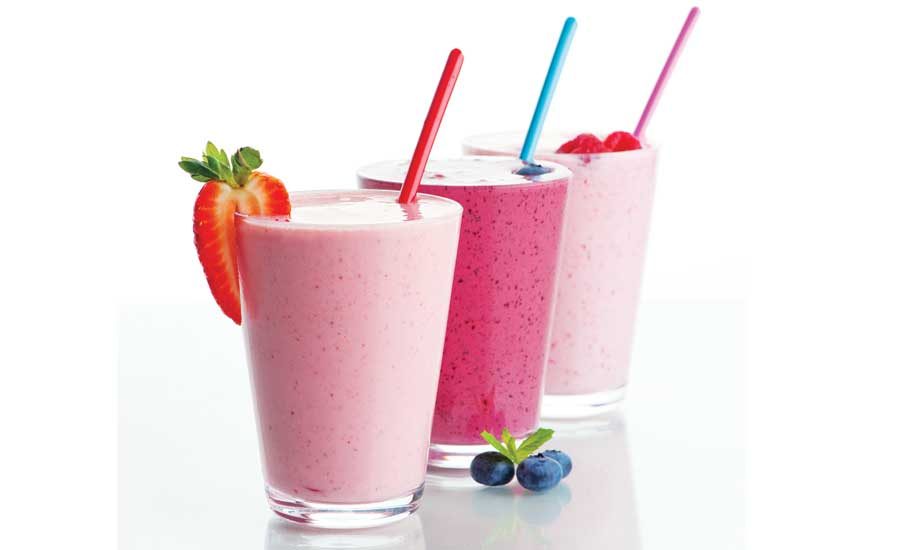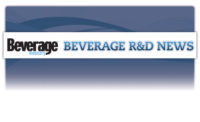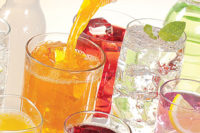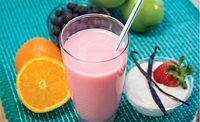Whenever consumers make Jell-O, thicken gravy or add corn starch to a pie filling, they knowingly or unknowingly are using hydrocolloids to thicken their products and give them a desired consistency. As health-and-wellness trends impact new product development, beverage formulators increasingly are using these ingredients to give consumers the clean label, nutrient-enriched beverages they seek, experts say.
Additionally, hydrocolloids can boost soluble dietary fiber, improve the mouthfeel of juices and juice smoothies and can extend a beverage’s shelf life by keeping solid ingredients in suspension so they don’t settle at the bottom, according to experts.
When deciding which hydrocolloids to use, beverage-makers are at no loss for options. Carrageenan, cornstarch, gellan gum, gum arabic, maltodextrin, pectin, tapioca starch, wheat flour and xanthan gum are just some of the many hydrocolloids that can be used in food and beverages.
“Clean label has contributed to a shift in which hydrocolloids are accepted by consumers,” says Rosa Sanchez, principal applications scientist at DuPont Nutrition & Health, St. Louis. “This has made formulators add and remove certain hydrocolloids … [because] protein-fortified beverages can have a gritty/sandy mouthfeel and more perceivable particles, which can be avoided with the use of a hydrocolloid or a blend of hydrocolloids.”
She adds that today’s progressive consumer, who is concerned with sustainability, label transparency and knowing how and where the products he or she is consuming come from, is driving the increased usage of hydrocolloids.
Brian Surratt, project manager in Cargill Texturizing Solutions at Minneapolis-based Cargill, expresses similar sentiments. “As protein beverages have increased in popularity, we have seen an uptick in customer interest in hydrocolloids, which are so vital to protein stabilization in beverage applications,” he says. “In neutral-pH beverages containing protein and electrolytes, carrageenan can stabilize proteins and provide properties such as thickness, viscosity, fat mimetic or creaminess aspects to one’s finished beverage. Protein stabilization is critical.”
Regarding neutral-pH beverages, DuPont’s Sanchez notes that algae-based carrageenan is a primary stabilizer for most neutral-pH dairy applications, while xanthan gum and cellulose are providing additional body, mouthfeel and viscosity to a variety of beverages.
Yet, protein also is being combined with ingredients that have more acidic properties. Cargill’s Technical Leader for Fruit, Beverage and Confections Wen J. Shieh says that he’s seeing an increased growth in protein beverages that combine juice and dairy, which further necessitates the use of a hydrocolloid to combat the acidic pH of these smoothie-style beverages.
“… To offset the chalky taste [and to] stabilize proteins in this pH environment, product developers turn to high-methoxyl pectins such as Unipectine AYD or Vitex AYD pectin, which coat the protein’s surface, preventing sedimentation problems,” Shieh says.
Among the hydrocolloids that Cargill offers for acidic beverages are pectin, xanthan gum and locust bean, while carrageenan typically is used for neutral dairy drinks as a stabilizer to suspend cocoa powder and improve mouthfeel, he adds.
DuPont’s Sanchez notes that pectin, a fruit- and vegetable-based gelling agent, is one of the company’s most popular hydrocolloids and is used to improve mouthfeel in juices and for protein stabilization in low-pH protein drinks. “Pectin has become more popular lately since it is perceived as a clean-label ingredient,” she says.
Solving the stabilization puzzle
Because formulators need to manage several factors, such as water content, viscosity, ionic strength and lipid and/or particulate suspension, control mechanisms like carrageenan can help solve the stabilization puzzle, Cargill’s Surratt says.
“Because of its charge density, carrageenan helps keep particles such as potassium, calcium, magnesium and proteins in suspension,” he explains. “These same electrostatic interactions enable carrageenan to entrap insoluble particles, such as cocoa or calcium salts [that are] used to fortify dairy and/or non-dairy beverages, as well as lower density constituents, such as fat globules.”
Dan Grazaitis, technology manager for beverages at White Marsh, Md.-based TIC Gums Inc., says hydrocolloids, such as guar gum, gum acacia and inulin, have been popular choices for supplementing food and beverage products because of their low viscosity contribution and highly soluble dietary fiber content.
“These products can be used at higher levels without negative impacts on texture or flavor,” he says. “Most hydrocolloids are an excellent source of soluble dietary fiber and have long been used for their digestive health benefits.”
TIC Gums has developed several hydrocolloids for beverage applications, he adds. For example, Nutriloid Gum Arabic FT-90 is designed to boost soluble fiber levels and improve mouthfeel in beverages without adding viscosity, he notes. “It has all the functional characteristics of gum arabic and contains a minimum of 90 percent fiber on a dry-weight basis,” he adds.
Recognizing the benefits of the various hydrocolloids, food technologists are finding ways to capitalize on those properties. DuPont’s Sanchez notes that hydrocolloid systems — which consist of a blend of hydrocolloids — are growing in popularity because they provide a "one-bag-solution" to beverage manufacturers.
Yet, as consumers seek reassurance about the safety of their beverages, they are demanding that they be made with a minimum of recognizable ingredients, TIC Gums’ Grazaitis notes.
“While the all-natural claim continues to be popular, consumers are interested in the sources of the ingredients,” he says. “In beverages, the top trends are around natural and safe stabilizers to provide suspension, emulsification and texture.”
Two of TIC Gums’ hydrocolloids, Ticaloid Pro 148 OG and Ticaloid Pro 159 OG, meet the need for clean-label stabilizers that provide suspension and texture modification in both dairy and non-dairy beverage applications, he notes.
Additionally, he highlights data from Chicago-based market research firm Mintel that indicates that 30 percent of Americans would be encouraged to drink non-dairy milk if it had more protein.
“Mintel research indicates that product and ingredient innovation could lead to further adoption of non-diary milk,” Grazaitis says. “… As more non-dairy milk beverage producers either add or increase the amount of protein in their beverages, more texture and stability issues need to be managed [in order] to produce a successful product.”
Maintaining mouthfeel
When it comes to using hydrocolloids in reduced-sugar beverages, maintaining mouthfeel remains one of the biggest challenges for beverage formulators, according to Cargill’s Shieh.
“Consumers want beverages with less sugar or lower calories,” he says. “That demand has many beverage companies searching for options to keep sugar levels in check, while still delivering the same taste and sensory experience as a full-caloric beverage. … Cargill has developed a proprietary technology, which uses tribology to shorten product development time. By incorporating hydrocolloids into low-caloric beverages, we can restore the mouthfeel to the beverage.”
Using this technology, Cargill developed its Trilisse QMF hydrocolloids system specifically to support the beverage industry. “These proprietary texturizing blends optimize and improve mouthfeel in reduced-calorie beverages,” he adds.
For dairy-alternative beverages, one of TIC Gums’ newest offerings is its Ticaloid Pro 181 AG, which satisfies clean-label requirements, improves processing efficiencies and addresses beverage formulation challenges, according to TIC Gums’ Product Manager Karen Silagyi.
“It also emulsifies and stabilizes oils found in non-dairy milk alternatives such as almond and cashew milk; therefore, also eliminating the need for soy lecithin,” she says. The Ticaloid Pro 181 AG is ideal for rice, nut, grain and soy beverages, which boast fewer calories and fat than dairy-based beverages, she adds.
Combatting challenges
As high-protein and dairy-based beverages increase in popularity, experts say that finding the right solutions for these applications can be challenging, particularly because of the stability and functionality of hydrocolloids in various pH ranges and interactions among the ingredients in a formulation.
“Some protein sources utilized in the fortification of protein-enhanced beverages can create strong astringency and/or texture defects. Other ingredients, such as cocoa powder and minerals, can settle and cause the beverage [formulation] to separate,” TIC Gums’ Silagyi explains. “Texture and separation can both cause an inconsistent flavor.
“And since hydrocolloids are utilized in product formulations to combat the negative effects nutritional ingredients have on texture and stability, … each type of hydrocolloid, which is multifunctional in nature, has a unique purpose to reduce the perception of particulates, decrease astringency and prevent sedimentation.”
To combat the challenges, it’s vital for beverage producers to consider their target consumer, expected shelf life, acceptable mouthfeel, along with pH and processing conditions, notes DuPont’s Sanchez. “Balancing cost also can be difficult when trying to achieve it in conjunction with a long, stable shelf life and a clean-label beverage,” she adds.
Additionally, experts note that supply chain and pricing is impacting the hydrocolloids market. “Hydrocolloids are especially vulnerable to supply chain and food safety, quality and regulation risks,” says Albert Cianci, product line manager for Cargill Texturizing Solutions. “The growing areas for hydrocolloids raw materials are far from the consumption points. Weather is always a concern, and long-term storage of raw starting materials is not feasible and can lead to product performance degradation over time.”





